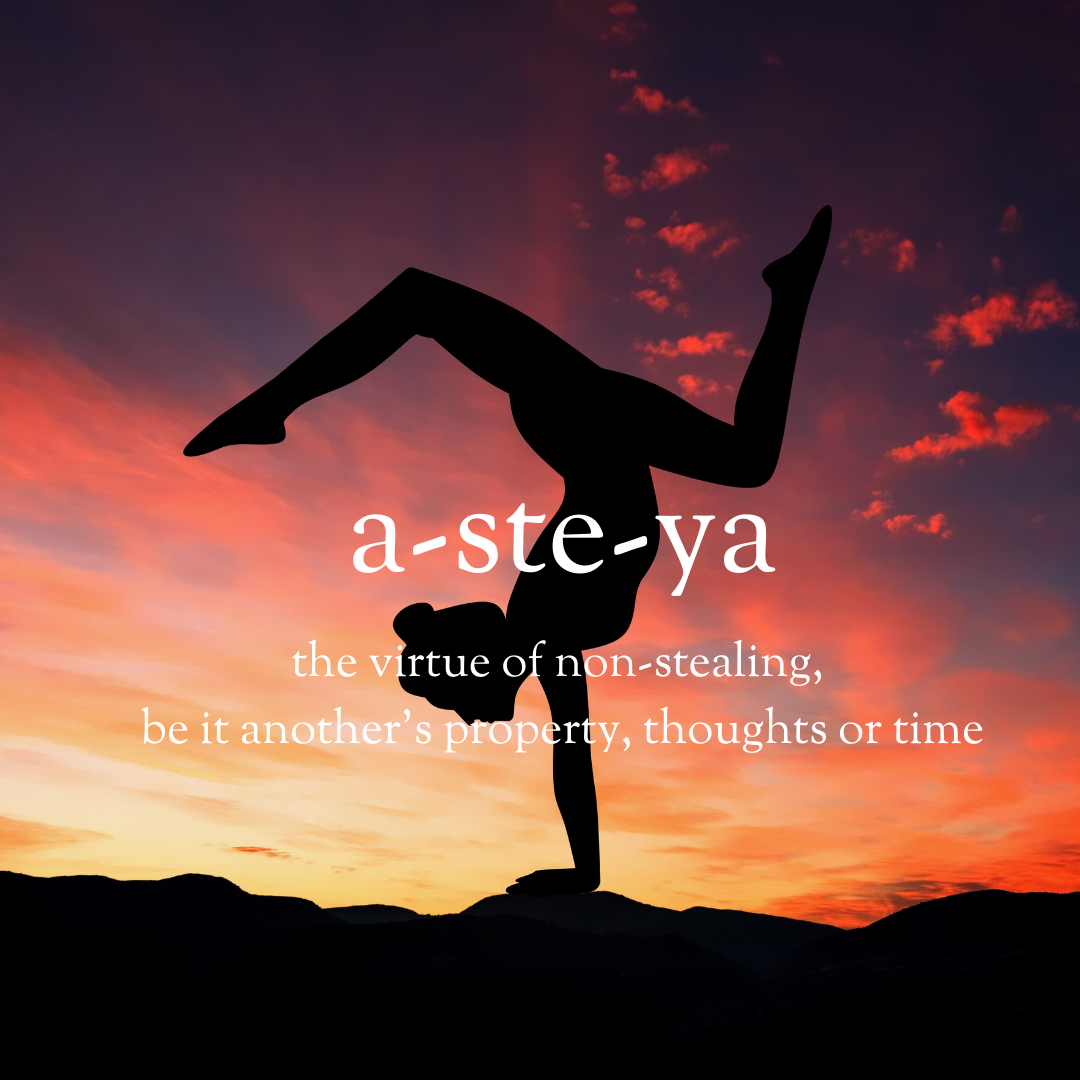Asteya - the virtue of non-stealing
“Comparison is the thief of joy”
--Theodore Roosevelt
The theme of September is Asteya.
What does Asteya mean in Yoga?
To steal is defined as: taking (another person's property) without permission or legal right and without intending to return. ASTEYA, or "not stealing," means more than not taking things that don’t belong to you. It is the third of the 5 Yamas, the ethical underpinnings of yoga for living in the right relationship with others.
Since the Yamas can also be thought of as restraints in how we live, that means that sadly we humans need to restrain ourselves from taking that which is not ours. We don’t like to think of ourselves as common thieves, yet we are always taking, whether it be food, air, sunlight, or even help from friends. Thus, asteya also means not taking that which is not freely offered, including not only material objects but also time, thoughts, energy, emotions, and ideas. We steal because we somehow perceive the universe as lacking abundance, or we think that there is not enough for everyone. To practice asteya means rooting out any subconscious beliefs of lack and scarcity that cause greed and hoarding.
There is this tendency of one’s mind to not be content with what we already have. Upon getting one thing, the mind still craves another. It is never-ending. Often, we find ourselves on a hedonic treadmill, remaining at a relatively stable level of happiness despite a change in fortune or the achievement of major goals. In a sense, we often reach for the next thing to satisfy our craving.
In the end, the one who is content with what he or she already has is the wealthiest because he or she wants for nothing. In yoga sutra 2.37 Patanjali says, “asteya-pratiṣṭhāyāṁ sarvaratn-opasthānam,” which translates to “When you are firmly established in non-stealing. Permanent prosperity results.” Inherent in the ethical principle of asteya is this concept of non-coveting.
When we covet something, we yearn for it and often feel that we are deserving of it. Stealing is the result of the craving for the possessions of others. This craving or compulsive obsessiveness to possess things that belong to others, makes the mind of the yogi move in a direction that is counter to yoga. Thus, from the yogic point of view you must cultivate non-stealing if you are to progress in yoga.
What does Asteya teach us?
The ultimate lesson of asteya is that there is already enough. We can, with practice, shift from a mindset of lack and scarcity to one of abundance and gratitude. Coveting what another has and comparing yourself to another leads to suffering. We are not ranked against each other; rather each of us is unique. We can act based upon the belief that the source of happiness and fulfillment lies not outside of us but within us.
If we operate on the premise of scarcity, we’ll not only hoard things but we’ll do things like overschedule our days because more is better. What makes anything meaningful is not the activity itself or checking something off your to do list, but giving your full attention to the activity itself. As John Lennon said, “Life is what happens while you’re busy making other plans.” Asteya reminds you that you never get a day back.
We can practice asteya formally on the mat or the meditation cushion, but more importantly we can take it off the mat into our daily actions.
On the mat: Practice Asteya in Yoga
Practicing asteya on the mat can help you explore the small ways you withhold care and respect from yourself.
You can practice asteya by honoring your body as it is today as you work toward your aspirations and goals. It can help you see if you are “stealing” poses. Are you trying to do poses that are not appropriate for you to do? Are you trying to fit into the pose rather than making the pose fit your body? Maybe some poses are not appropriate for you, yet you feel that you “should” be able to do them or used to be able to do them. Perhaps you see others in class and find that you are constantly comparing yourself to them. If we are caught up in what someone else looks like, we are missing the experience of yoga. Can what you are able to do on the mat be enough?
As Theodore Roosevelt said, “Comparison is the thief of joy.” We may find ourselves comparing not just in poses but on the meditation cushion. Ideas of others sitting stiller or being more focused, present, and mindful, are common stories that plague our minds.
If we can leave our egos at the door when we come to class and move from comparison to gratitude and respect, we can leave with a deeper, more honest relationship with ourselves.
Mudita, is one of the four keys to happiness known as the Brahmaviharas and is translated as sympathetic joy or taking pleasure in the good fortune of another person. Here’s where on the mat or the meditation cushion you might be able to see “comparing mind” or envy and sit with it. See it. Feel it. Name it. If we can bring attention to those feelings and label them, they lose their power and begin to dissipate. We can feel what lies underneath those feelings…joy.
As we move away from the feeling that there is not enough happiness to go around, we can rejoice in the good fortune of others. Even using a silent phrase like, “May your happiness and good fortune continue to grow,” can get you out of “comparing mind” and any ideas that there is less happiness to go around. If you are comparing yourself to the yogi next to you in class, you likely do the same in other life situations. Working with these feelings on the mat is one of the most accessible places to cultivate asteya.
Practice Asteya Off the mat
Beyond the surface level of not stealing money, hoarding materials you don’t need, or coveting what other people have, asteya carries much deeper meaning.
We must not steal people’s ideas, words, time, and we must not mindlessly consume natural resources. Maybe at some point in our lives we’ve even stolen someone’s happiness. To practice off the mat, is to cultivate gratitude and generosity, the opposite of stealing and coveting.
The simple act of “paying it forward” is the opposite of stealing. We can be generous with all kinds of non-material things. We can be generous with our time, attention, energy, presence, information, knowledge, encouragement, understanding, kindness, and love.
When people do nice things for others unexpectedly, that produces gratitude and increases the likelihood that people will do something “in kind.” With a gratitude practice, we train the brain just like in any mindfulness practice. We intend to notice– to take in the good.
Paying attention to what you’re grateful for can switch the channel of negative thinking and help you appreciate what is here in your life right now. Here are six ways to cultivate gratitude:
● Keep a gratitude journal - Write down each day the gifts you’ve received.
● Write a thank-you note - You can make yourself happier and nurture your relationship with another person by writing a thank-you note
● Better yet…Thank someone face to face or even mentally.
● Recap at meals the highlights of the day.
● If you regularly pray, use it as a method to cultivate gratitude.
● Mindfulness meditation involves focusing on the present moment without judgment. In meditation, we acknowledge the good right now, even the challenges. Our happiness is then not dependent on conditions being a certain way. Instead, we cultivate a sense of gratitude amid whatever is happening in life.
Practice gratitude and give back.
The yogic path teaches us that we have all that we may ever need within ourselves, and we needn’t want for anything at all. When the practice of asteya becomes embodied, you learn to appreciate rather than reaching for something new in hopes that it will make you happier.
Gratitude helps us refocus on what we have instead of what we lack, making it easy to not covet. By making generous offerings or thinking generous thoughts, we open up to the loving, abundant, good-natured core of ourselves. We realize that it is never the accumulation of things that brings us satisfaction.
Truly practicing asteya allows us to be grateful and to give back, whether it be with our time and attention, how we treat the environment and those around us, or even volunteering for a cause.
Our respect for ourselves, our sense of gratitude and appreciative joy, along with our generosity and kindness, will result in generosity and kindness from others. In the end, Patanjali's simple directive of non-stealing results in the greatest prosperity.
If you want to practice Asteya in Yoga, feel free to contact us.
Book a consultation and start working today with Wellness and Yoga Coaches.
Become your best self.




